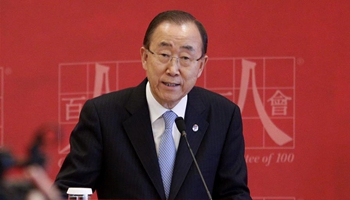WUHAN, July 9 (Xinhua) -- Dike patrolman Shao Wentao, 34, has been bowed down with anxiety in recent days.
Looking across the Yangtze River at Wuhan, the mudflats he had inspected dozens of times were completely submerged by turbid water.
"The river is going up and our 'territory' is getting smaller and smaller," he said.
Shao is working in a 40-strong team responsible for patrolling a 2-km-long segment around the clock of any signs of troubles, including seepage and bubbles, that could lead to a breach of the embankment.
As the rain continues to fall, water is above the alert level in provinces of Anhui, Hubei, Hunan, Jiangsu and Jiangxi, reaching 28.37 meters in rivers in Wuhan this week, the fifth highest in the city's history, and the highest level in 17 years.
Shao has been on the beat for years. "Nothing can be compared with this," he said, pointing to trees and brick houses that have been partly underwater for days. Less than 100 meters away are dozens of residential high rises, some still under construction.
With more than 10 million permanent residents, Wuhan is the most populous city currently threatened by floods. Parts of the city are often flooded for several days at a time when the Yangtze rises.
Wuhan government has called up more than 30,000 people ranging from government officials to ordinary citizens to closely monitor its 308-km of embankment.
A problem was detected on Monday in Qingshan in the city's northeastern quarter and quickly dealt with when dozens of heavy trucks poured tonnes of gravel for over 10 hours.
In Hunan, precipitation in some areas has hit record highs.
"The heavy rain is closely connected with El Nino effects, which appeared to be the strongest since 1951," said Zhou Bing, chief observer of the National Climate Center.
Although there have been no breaches in major cities along the main stream, urban areas have suffered severe water logging and many villages along tributaries have been submerged.
Neighborhoods adjacent to Nanhu Lake in Wuhan have remained 1.5-meter deep in water for more than five days and residents have had to take boats to enter or leave the area. Thousands of people have been evacuated.
"To try to drain the area, our 15 pumps have kept running at full capacity for eight days," said Zheng Wei, director of a local pumping station. "We have pumped as much water out of the city in the past week as we normally pump out in six months."
The city has 16 large pumping stations, all working 24 hours a day.
There is some good news though. The rain has temporarily abated, and the Three Gorges Dam, the world's largest hydropower project built a decade ago to reduce the potential for floods, has retained much water upstream.
However, local flood control authorities cannot let down guard yet, as the flood peak usually comes in the late July or early August.
The Yangtze will see an even stronger wave of floods if downpours strike upper, middle and lower reaches of the river simultaneously, said Chen Guiya, deputy director of the Yangtze River Water Resources Committee.
"The hardest battle is yet to come," Chinese Premier Li Keqiang said during a visit to sodden regions this week.










